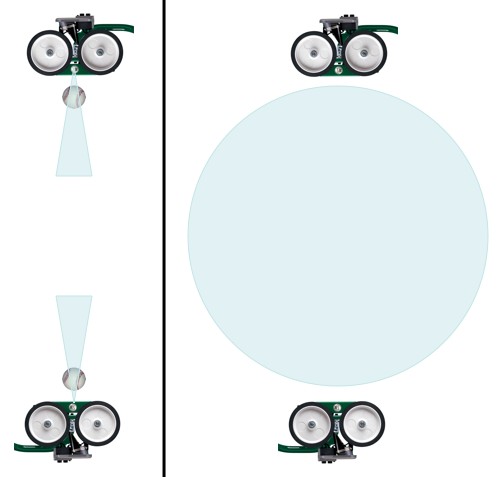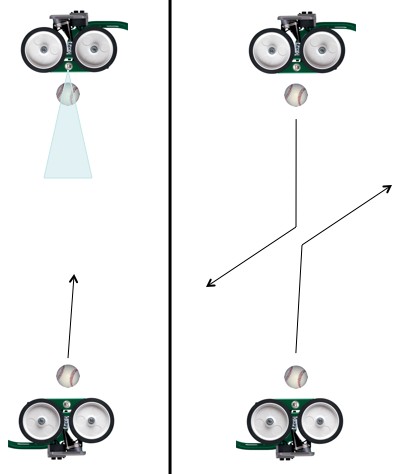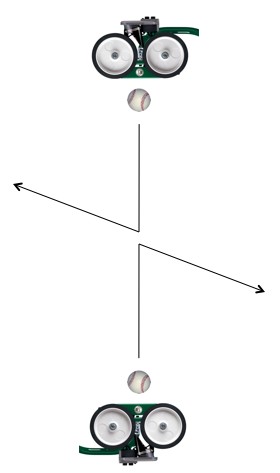Physicist: This is a follow up of this post, that would’ve been too long and meandering with this included. To sum up that post, a “measurement” is an interaction that exchanges information.
In the Copenhagen interpretation, what that measurement does is a magical rearrangement of the whole universe, faster than light.
More accurately (and here’s the answer), a measurement establishes an “entanglement” between the things involved.
A quick word about entanglement: Say you’ve got two marbles in a hat that are identical in every way, other than their color: red and blue. You and a friend each take out a marble without looking at it. You could have either one, but you don’t know which. What you do know, is that if you have the red marble your friend will have the blue marble, and if you have the blue, they’ll have the red. The marbles are correlated. If you each look, you’ll find that you never have the same color.
Obviously, your marble is in one state: either it’s red or it’s blue. In quantum mechanics however, a thing can be in multiple states, and amazingly enough, you can still have the same kind of correlation. You have a marble that is both red and blue (a red/blue “super-position”), and so does your friend, and yet they are both correlated such that they always have opposite colors. That is, just like in the non-quantum example, if you each look at your marble you’ll find you never have the same color. This multiple-state-yet-still-correlated thing is called “entanglement”. If you’re confused, then you’re awake. Back to the question:
Imagine that, for some reason, you and a friend get some pitching machines and start chucking baseballs at each other. Just to see if you can, you set up the machines so that they fire at the same time and the baseballs hit each other in mid-air. Now, pitching machines aren’t perfect, so the balls won’t always take the same path, just one that’s more or less forward. In particular, there’s no way to predict what angle they’ll hit each other at, and in what directions they’ll bounce apart.
After the collision there’s not a lot you can say about the trajectory of each ball. One thing you can say for sure is that, regardless of the direction one ball flies, the other ball will fly off in the opposite direction. After the collision their trajectories are correlated (maybe not perfectly, but follow me here).
Now look at the same situation from a more “quantumy” perspective. The pitching machines throw the baseballs, not in one of many slightly different trajectories, but in all of the possible slightly different trajectories.

Each baseball, rather than following a single path, takes a super-position of every possible path (in a cone). After the collision the balls are still in a super-position of every possible resulting path, but must be traveling in opposite directions. Correlated super-positions = entanglement.
Clearly the collision conveys information, so it is a measurement. The information is pretty straight forward (“you are being hit by a baseball”), but it’s still informative. Surprisingly, the effect of that measurement depends on your perspective.
From an outside perspective: both baseballs move toward each other in many, uncorrelated, paths. A “baseball probability cloud”. I say that they’re uncorrelated because even if you know which path one of the baseballs is taking, you still know nothing about the other.
When they collide and bounce apart, they’re still traveling along a super-position of many possible paths, but now they’re correlated.
Their collision (and mutual measurement) has entangled their states.
From an inside perspective: each state of each baseball thinks of itself as the only state. An “inside perspective” means picking one state out of the many, and thinking about what it’s life is like (to be needlessly over-the-top exact; “…picking one bundle of indistinguishable states out of the many…”).

After it’s fired, if you look at just one state of the bottom baseball it looks “non-quantum” and follows one path. From its perspective the other ball is in a super-position of states. But, when they collide they measure each other, and suddenly see themselves and the other ball in just one state. Note that each of the different states experience this.
Before they collide, one ball sees the other ball as being in many states. When they collide they suddenly see the other ball as being in one state. So, from an “inside” point of view, measurement looks like “wave function collapse“, one of the great weirdnesses of the Copenhagen interpretation (“collapse” = “all but one state disappears”). When a ball bounces away from the collision it still sees itself going in one direction, and (since the balls always bounce in opposite directions) it’ll definitely see the other ball going in only one direction.
Their collision (and mutual measurement) has collapsed the state of the opposite ball (from the perspective of both balls).
But keep in mind that every state of both balls sees a (different) wave function collapse. There’s nothing special about either ball; they’re both in many states.
Just for fun, a very outside perspective: Say you’re in another star system, and you can’t get any real information about what’s going on. You see not just the baseballs in many states, but the people involved as well. After a collision, the people running the machines see the baseballs as being entangled. Now say one of them (Bob) tries to find one of the balls. When he does, he suddenly knows where the other ball is. Bob’s excited because he just experienced wave function collapse for the octillionth time that day. Also, since the balls were entangled, he’s instantly “collapsed the wave function” of the other ball (he now knows where it is).
But, from your very outside perspective, Bob’s many states are searching for the ball’s many states. Each of his many states eventually finds one of the ball’s many states. Now, from far enough out, we can’t tell where each of Bob’s states finds the ball. All we can say is that the wherever the ball is, that’s where Bob will find it. That is; the state of the ball that bounced east from the collision will be correlated with the state of Bob that finds the ball to the east of the collision. Both Bob and the ball are still in many states, but now they’re correlated. By finding the ball, Bob (in his many states) is now entangled with it.
Even more awesome, since the baseballs were already entangled with each other, by entangling with one, Bob entangles himself with both. That’s not too impressive from Bob’s perspective, but it can seem spooky from a very removed perspective.








Pingback: Ninth Linkfest
Pingback: Skammtafræðileg athugun | Manntal
Pingback: Q: If quantum mechanics says everything is random, then how can it also be the most accurate theory ever? | Ask a Mathematician / Ask a Physicist
Pingback: Q: What is quantum teleportation? Why can’t we use it to communicate faster than light? | Ask a Mathematician / Ask a Physicist